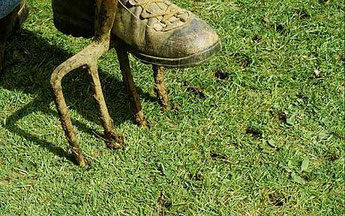I have an opportunity for a self employed garden drainage specialist to take on leads information
How to aerate a compacted and waterlogged lawn
Aerating simply involves making small, but fairly deep holes through the grass into the soil. The holes allow air, water and essential nutrients to get from the surface into the soil.

Does aerating stop puddling on my lawn?

A read for rainy days
In fairy tales, there is always a
Prince Charming and a bad man. Sometimes in real life, Prince Charming is the bad man, or the
bad man turns out to be Prince Charming.
Please be aware, this is not a fairy tale. This book contains references to grooming gangs, sexual abuse, Gaslighting, and punishment of the abusers. Also NON-WOKE scrutiny of British
society.
A dark story of gaslighting, sexual abuse, retribution, and hope. Based on the author's conversations with Willow, a young girl hidden from Society, and with Richard an ex-soldier now working for
a covert agency The Organisation. This book tells how Richard confronts those in authority blocking Willow from the therapy she needs to escape from them and recover, he’s aware of the
consequences. But having ignored evil too often, he’s ready for the risks.
CLICK LINK FOR FREE READ SAMPLE Kindle version Paperback
Aeration is an important factor in keeping lawns healthy and helps stop waterlogging.
These are the main benefits of aerating a compacted lawn.
- Aeration breaks through the thick thatch that sometimes builds up, especially in neglected lawns, between the grass and the soil and also breaks through the compacted soil below the grass, common in lawns that get heavy use. Without aeration, nutrients and water will be unable to pass through the soil to reach the grass roots, starving the grass and feeding the weeds instead. And causing rainwater puddling on the surface and eventually evaporating instead of percolating into the lawn.
- Stimulates new root growth.
- Helps with lawn drainage and absorption.
- Increases the uptake of nutrients.
What time of the year is best to aerate a lawn in UK?
The best time to aerate is during the growing season avoiding very hot weather that makes the soil dry and difficult to penetrate, so early or late spring or autumn are the best times, but anytime (tine) is better than none.
How do I know a Lawn Needs Aerating?
The signs that tell you your lawn needs aeration are not always obvious, but lawns especially on heavy clay soil that get regular heavy use and show wear and tear and thinning, turning brown quickly in dry weather need to be aerated on a regular basis, at least once a year. Or you may have had a visit from Mike the flowerpotman to investigate a lawn drainage problem who to your relief tells you that the lawn is compacted and won't need to be dug up and drainage installed, just aerated.
Your lawn will need aerating if:
- The surface feels hard and you can't easily sink a shovel to a depth of half the blade
- Water puddling on lawn after rain for longer than a couple of hours.
- Vehicles driving or parking on lawn or heavy play use.
- Thatch thicker than one-half inch.
- Difficulty pushing a pencil into the soil.
- Heavy clay soil. Tips to break-up clay
- Thin, patchy or bare patches in grass (worth checking out other causes like Leather jackets first)
Tools and materials to help aerate your lawn
- Heavy Duty Aerator for compacted soils and lawns
- Removes cores for longer lasting aeration particularly on clay soils
- Use anytime for all over lawn aeration
- Aerating helps revive dry patches or hard areas
- Helps reduce moss in damp areas by improving drainage
- Aerating with this heavy duty aerator after installing french drains helps the system work to full capacity.
- Easily the simplest tool to use I have found.
- Large 300mm (12") width covers your lawn quickly and easily
- Thirty 45mm (2") spikes provide deep and even aeration
- Supplied in either green or black
- Helps lawn to breathe, encouraging deep root growth and a lush, green lawn
- Quick and easy to assemble - see instructional video on Greenkey website
- A fast and efficient way to keep your lawn aerated
- Simple effective Lawn Aerator: Our lawn aerator shoes nails are designed with 26 heavy duty metal 30 mm spikes and 2.2 inches in length, the lawn shoes are easy and fast to poke into the deep soil, helping grass absorb water, nutrients and air from the deep roots to make your lawn more green and healthier.
- Durable Spiked Sandals: Lawn spikes shoes is made with With 4 upgraded versions of durable zinc alloy metal buckles & 1 elastic band, the base is made of Polypropylene and HDPE to ensure you are safer while using.
- One Size Fit All: Our Heavy Duty spiked sandals shoes has 4 adjustable straps & 1 elastic band, and alloy mental buckles, simply adjust the length of straps through the mental buckles to have a good secure fit, whether your feet are big or small, these shoes will fit like a glove.
How to aerate a lawn
Writing your first book or novel? This new website provides advice and tips to help write, edit, publish, market and promote it https://www.faircop.com/
